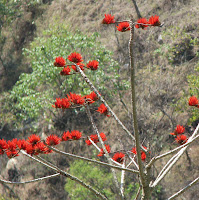I have to admit, I’m much more accustomed to traveling on Qatar Air in the middle of the night. In fact, I was surprised that there even were daytime flights – I’m not certain we have ever been on one before. On the plus side, this was an extremely full flight heading for Katmandu and we were lucky enough to be upgraded to Business Class! What a luxury! There’s room to cross your legs, an armrest that you don’t have to fight over and even something of a foot rest. Did make me change my mind…it IS possible to sleep on a plane.
 We arrived at Katmandu late in the evening – around 10:00 or so – and began looking for our guide who was to meet us at the airport. We searched everywhere, or so we thought. We did find the Hyatt bus there and finally, as it approached 11:15 and the airport was emptying out, we decided to go to the hotel; the airport really didn’t seem like a comfortable place to be staying in the middle of the night. Sadly, we just didn’t look in the right spot – our guide was there, looking for us and somehow we missed them. They came out to the hotel for a midnight meeting – and to let us know that we needed to be up at 5:30 to get back to the airport to catch the plane to Pokhara. Here we were, at a luxury hotel, beautiful room, gorgeous bath that rivaled the Japanese bath, yoga mat, beautiful view…and we got 5 hours of sleep and left even before breakfast! Sad, very sad.
We arrived at Katmandu late in the evening – around 10:00 or so – and began looking for our guide who was to meet us at the airport. We searched everywhere, or so we thought. We did find the Hyatt bus there and finally, as it approached 11:15 and the airport was emptying out, we decided to go to the hotel; the airport really didn’t seem like a comfortable place to be staying in the middle of the night. Sadly, we just didn’t look in the right spot – our guide was there, looking for us and somehow we missed them. They came out to the hotel for a midnight meeting – and to let us know that we needed to be up at 5:30 to get back to the airport to catch the plane to Pokhara. Here we were, at a luxury hotel, beautiful room, gorgeous bath that rivaled the Japanese bath, yoga mat, beautiful view…and we got 5 hours of sleep and left even before breakfast! Sad, very sad. A 5:30 wake-up? I thought we were on vacation? Dutifully we got up, showered and made it downstairs in time to meet Bill, the man who orchestrated our trip and our guide, Tserig. He proved to be a delightful travel guide and great person to hang out with. He was always ready to answer our crazy questions – and find out the answer if he didn’t know it. Fortunately, he was going to be on the flight with us – a good thing since it seems that while most Nepalese in the big city speak some English, not all of them do. It was good to have someone who knew where we were going and could understand the loudspeaker announcements.
The International portion of the Katmandu airport is fairly modern with pretty up-to-date equipment and services…the domestic terminal, right next door, has the looks of an airport built sometime in the 50’s. The old scales, all hand signs, many more pat-downs for security – and much less intrusive than what they do in the US. The plane was very small – no more than 20 people. There was coffee service available…instant that is.
 Pokhara is a much smaller town than Katmandu – something to be said about small airports and small towns – makes it a bit easier to get around! Wares are sold on the streets, fresh fruits and veggies from various carts, knock-offs from name brand items everywhere. Many carts sell various prepared foods too, though our western stomachs might have been unhappy with some of those delicacies so we stuck to the tea houses and restaurants that catered to the tourists. It was here we met our driver who was to take us to the trail head for our trek up into the mountains of Annapurna.
Pokhara is a much smaller town than Katmandu – something to be said about small airports and small towns – makes it a bit easier to get around! Wares are sold on the streets, fresh fruits and veggies from various carts, knock-offs from name brand items everywhere. Many carts sell various prepared foods too, though our western stomachs might have been unhappy with some of those delicacies so we stuck to the tea houses and restaurants that catered to the tourists. It was here we met our driver who was to take us to the trail head for our trek up into the mountains of Annapurna. 















































